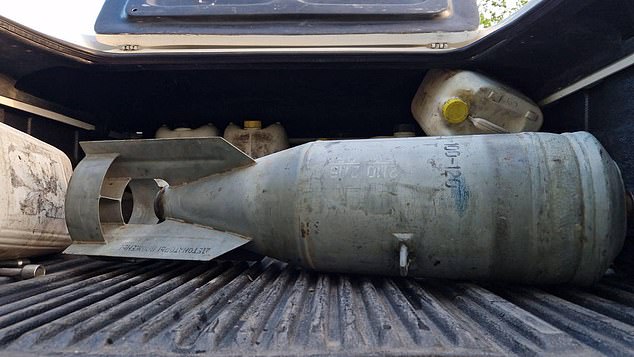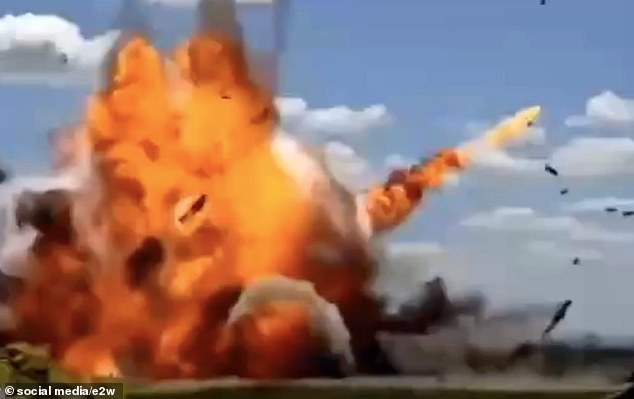The night I joined an ultra-secret Ukrainian special forces unit raining destruction on a weapons factory hundreds of miles INSIDE Putin’s Russia
The man cradles the 100kg bomb in his father’s arms before gently placing it on the back of the truck. It is a small rocket that curves into a rounded stump.
He loads it with C4 plastic explosive, and punctures the pink, plasticine-like substance with a strip of metal about eight inches long. Then the fuse goes in. Now the bomb is ready; within a few hours he will destroy his target.
I am in northeastern Ukraine, doing what no journalist has ever done: joining a special forces unit on a mission of the highest national security – a strategic strike, hundreds of miles into Russia itself.
Hidden in a field of thick grass and bluebells, the scene is unusually peaceful. From beauty will come destruction.
“You want to know how to hurt Russia? Hit them in their own country. Bring them the terror they bring to the world,” says Ivan, the commander of an unmanned aerial vehicle (UAV) unit. “Russia can send conscripts to Ukraine endlessly. They are considered the lowest maggots in their country – completely expendable.”
David Patrikarakos is the first journalist to join a special forces unit on a deep raid in Russia… he is seen here through a night vision lens
Ivan’s men have a specific task: they appear from nowhere to launch attacks on targets deep in Russia, only to disappear again.
‘On social media you often see the results of a successful attack behind the lines. Often it’s us. Sometimes no one knows except the enemy,” Ivan tells me. “But the enemy certainly knows.”
Moscow may be sending its human waste to Ukraine, but it is far from the front in Russia that the arms factories lie, the drone workshops, and everything else the country needs to keep its terror machine running with murderous efficiency. It is all about interrupting the war process, Ivan explains.
The Ukrainians don’t have enough bombs to take out a large multi-story weapons factory, for example. But they can strike a smaller factory that supplies vital Russian war components. With Ukrainian weapons so limited, accuracy—and creativity—are key.
And they are successful. Over the past six months, Ivan’s team has inflicted $200 million in damage on the enemy.
“Every operation takes days, sometimes weeks of planning. Every objective is unique; and we cannot afford to make mistakes.”
The point is to find the weak spot in the weapons production system; the components of weapons that are irreplaceable or can only be replaced – and even then inadequately – with cheap Chinese technology.
“The Russians still have big problems. All their best equipment is based on technology from the 1980s,” Ivan continues. “They use Iranian Shahed drones because they can’t make Tomahawk missiles. We are outnumbered and outgunned, so we exploit every vulnerability they have.”
The need to directly attack Putin’s war machine – rather than kill the endless stream of grunts he sends to Ukraine – is why Kiev is desperate for permission to use US-supplied weapons in Russia; and why more countries, including Britain, are finally giving Ukraine the green light to do so with the weapons it supplies.

The 100 kg payload loaded on the drone was directed towards Russian targets
I was introduced to Ivan by Taras, a unit member and my friend, so he could decide if I could be trusted. I passed the test and two days later I am in the car with Ivan and two of his colleagues, Rodion and Valeriy. All I’m told is that we’re “heading north.” Next to me, Valeriy explains another advantage of the deep attacks: their psychological impact.
‘Imagine you are a Russian conscript guarding ammunition deep in Russia. You have never been to the front; every now and then you pick up your rifle and pretend to be on patrol, but you know there is no serious threat.
“But then one night, as you lie in your warm bed, you hear a sound in the air and suddenly your world explodes.”
He pauses and grins. ‘And right now we’re sitting hundreds of miles away drinking a cup of coffee.’
As we approach the location where the drones will be launched, my phone is taken from me and placed in an insulated bag, preventing it from sending or receiving information. The soldiers all have secure phones. We pass through grassy checkpoints and enter a small, impoverished town of low-roofed buildings and cramped, brightly colored shops selling everything from phone cards to cheap shoes.
The ground becomes uneven. The landscape changes from concrete to scrub. We get closer. Finally, a few hours after we left, we arrive at the mission site and park in a grove of trees.
We are now within range of deadly Russian glide bombs. Valeriy opens his laptop to show a ‘live’ map. I can see enemy aircraft patrolling the skies. He is ‘assessing air threats’, specifically checking that no Russian drones are coming our way. We are now waiting for ‘the device’ — the drone — to arrive.
Meanwhile, I am being eaten by mosquitoes. They bite my neck, my arms and — confusingly because I am wearing pants — my legs. I curse and try to swat them away. I look at Valeriy who is standing stoically next to me. ‘Aren’t you bitten?’ I ask. ‘Yes,’ he answers, ‘I just don’t tell you.’
Then I am reminded — again — of what can and cannot be reported or filmed. ‘I’m sorry for all this,’ says Valeriy. ‘But there is no choice.’
Things are getting tense. Rodion retrieves an automatic weapon from the car, inserts the magazine, and tests the sights. Finally, the “gadget” arrives. It’s being towed behind a vehicle in a large trailer. I walk over to inspect it and find something I didn’t expect. The “gadget” is actually a small two-seater passenger plane, about ten feet long. Only something this size could carry such a large load.
The aircraft has been converted to remote flight and is now being assembled.
There is a wing on the ground. Several men stand around it working on the body, screwing in parts and checking the electronics.
Next to a three-bladed propeller on the nose are two black triangular slits that resemble eyes and below that two rectangular slits that resemble a nose and a mouth. “It looks like a cat,” says Ivan. “Yes, an angry cat,” I answer.

A Russian tank is smashed to pieces during a Ukrainian drone strike
Eventually I am told what the purpose is: a power plant for an arms factory 200 miles away in western Russia. In fact, the goal is more specific than that.
They would need ten bombs to destroy the factory and several more for the power plant. They only have one bomb, so it’s the transponder [power source] in the power plant that is to be affected. Take that out and the plant stops functioning. The production chain is completely broken.
The device has been assembled. The men high-five each other and tell me it will take off in the dark. The sun sets, a burning red window disappears into the horizon. “Beautiful Ukraine,” I say to three soldiers standing next to me. “Yes, but not a good time for Ukraine,” they answer.
“F*** Russia,” is the general agreement.
Night falls. The machine is driven onto a concrete path that will serve as a landing strip. Men gather to perform final checks. They all have red lights on their foreheads.
These are harder to see from the air and help to avoid unpleasant enemy attention. The 100 kg load we have brought with us is driven onto the ‘runway’ and attached to the base of the aircraft. We are almost ready to launch.
I head to a mobile command unit where the path of the UAV aircraft has already been mapped out. The men inside, I discover, were commercial airline pilots in civilian life.
As Ukraine converts aircraft into UAVs, it needs their skills to wage war as effectively as possible. One of them, Oleksandr, will remotely pilot the aircraft as it takes off, before it switches to autopilot.
I go outside and watch the plane under Oleksandr start moving. It will take off about 200 meters away for safety reasons. If it crashes or is shot down, we don’t want to be anywhere near the 100 kg bomb — the explosion can be deadly up to 100 meters away. Once it’s in the air, everyone gets in their vehicles and we drive away quickly. We don’t want to be anywhere near it when it’s spotted.
A little later we arrive at a café. The mobile unit tracks the UAV – a dot that moves steadily across an electronic screen.
Finally I eat: slices of ham and cheese on white bread. It’s basic, but delicious at the moment.
After a few hours: success. The UAV is on its way back. The men are happy.
I am shown a video of a target being destroyed. I look at my cup of coffee and remember Valeriy’s words; and I smile.
The next morning, the official Russian response came via the messaging app Telegram, in the form of a statement from the region’s governor.
“An attempt by the Kiev regime to carry out a terrorist attack using a UAV was stopped,” it said. ‘An aircraft-type unmanned aerial vehicle was destroyed by air defense forces of the Russian Ministry of Defense.
‘There were no casualties or damage. Operational and emergency services are working on site.’
This is followed by an almost identical copy from the Russian Ministry of Defense itself.
“Russians, always f***ing lying,” is Ivan’s simple answer. Later I will discuss the operation with Taras. “World War III is no longer a fantasy, David,” he says. ‘And we in Ukraine are like the Great Wall in Game Of Thrones: the defense of the Western world.’
He continues: ‘Europe seems to finally understand the problem. But it doesn’t have enough ammunition, or big enough armies.
‘If Russia beats us, Poland will fight, but if defeated, the last front will be Britain. Germany has no army; France does, but David, you have been at the front: they do not have the resources to fight like that. There are no planes there. It’s all drones and artillery.’
War is ultimately an economic struggle. We are in an economic war with Russia and we are losing. Ammunition in Russia is ten times cheaper than in the West. That’s why Ukraine must attack everything it can inside Russia — and that’s why we must not fail in our efforts to help it.
I think back to something Ivan told me. ‘We fought for the idea of a free world not for two years but for ten years,’ he said. ‘We are truly grateful for all the help, but we are struggling.
“If we can fight Russia with such small numbers, then surely you can too. It is time to be brave, for hard times lie ahead. As your great wartime leader once said, ‘We have nothing to offer but blood, sweat and tears.’
“Let’s remember his words – and do it together.”
